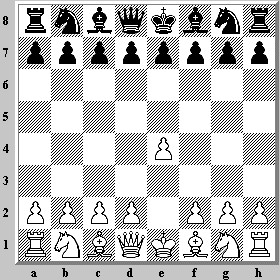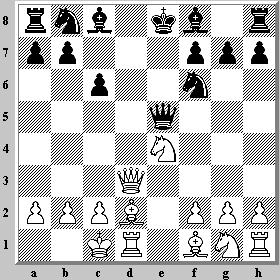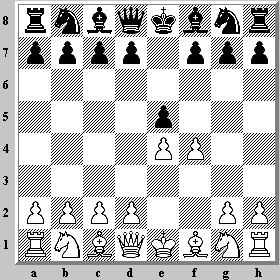A Winning Game Plan

The Initial Position
In chess, a winning game plan starts with the first move.
The objective in the opening of a chess game is to reach a good position.
The principles of opening play follow the general principles for
positional play.
The key for both sides is that White moves first.
White spends the first part of the game trying to convert this temporary advantage into something more lasting.
Black tries to eliminate White's temporary advantage.
The initial moves have been studied and mapped since the first Pawn was pushed hundreds of years ago. Here are tools to help you understand better this critical part of a chess game.
It doesn't matter how creative you may be in the middle game or endgame if you lose in the opening. Avoid the quick knockout and get a comfortable game. Maybe even deliver a quick knockout yourself!
Recommendations for Specific Moves
Step through the moves to reach the best known and most popular openings. Either start here...
...or, jump immediately to a specific opening by position or name...
...Once you locate a specific opening, you can see our recommended continuations.
The First Move

After 1.e4
- Introduction to 1.e4
No chessplayer can ignore 1.e4, when White already attacks on the first move. Half of your opponents are going to open with the King's Pawn - how do you react?
- Introduction to 1.d4
The initial position of a chess game is nearly symmetric. Only the position of the King and Queen breaks the symmetry, and this makes all the difference between 1.d4 and 1.e4. In most games opened with 1.d4, White plays an early c4 followed by Nc3.
- Unusual First Moves
The initial position shares a feature with all chess positions -- the legal moves do not all have equal value. What distinguishes the good moves from the bad moves, and from the not-so-bad moves?
Build an Opening Repertoire
- Part 1 : How to Avoid Losing in the Opening.
Here's how to avoid losing a chess game in the opening. It's a simple procedure that can be used by all players from beginner to expert, including the best in the world. What do grandmasters know that the rest of us don't?
- Part 2 : Select One Move for each Critical Position.
An opening repertoire is a nice expression that means 'if my opponent moves there, then I'll play here', where the preparation is done at home. Not only will it help you get a good game in the opening, it will also start you thinking about a chess position the way the best players do.
- Part 3 : Practical Considerations.
Keep your repertoire balanced, consult references, consider your strengths & weaknesses, use your computer, and track your results. Don't be surprised as your playing strength improves. You're on the path to becoming an expert or better.
Tutorials
We have a growing number of tutorials covering general aspects of the opening as well as specific openings...
Check back from time to time to see the latest tutorials.
Opening Traps

Black to move.
- Exercises
(offsite)
No one likes to get caught in an opening trap. Here are a series of exercises designed to test your sense of danger in the opening.
Opening Gambits

The King's Gambit
- Part 1 : 1.e4 e5 and 1...e6
How many different gambits and counter gambits are there? Part 1 covers 1.e4 e5 and 1...e6. Almost half of these are variations of the Kings Gambit.
- Part 2 : Everything except 1.e4 e5 and 1...e6
Part 2 covers all openings except those that start 1.e4 e5 or 1...e6. The Queen's Gambit is in our list even though it's not a true gambit, but it's not the only so-called gambit which is too dangerous to accept.
References
- Chess Glossary : Opening Terms
(offsite)
Chess terminology is at its most colorful in the names that have been applied to the openings and their variations. Chess also has a technical vocabulary which applies to opening theory in general.
- References, ECO Opening Codes, and More
(offsite)
See our reference links to know more about the most common openings and their names.
The
ECO
(offsite)
reference sites have lots of material.

